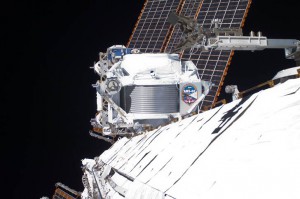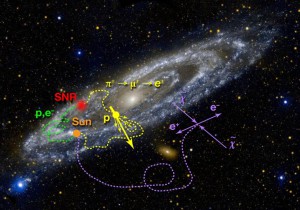In today’s A Lab Aloft entry, International Space Station Program Scientist Julie Robinson, Ph.D., continues her countdown to the top ten research results from the space station, recently presented at the International Astronautical Conference in Beijing, China. Be sure to check back for daily postings of the entire listing.
Number three on my countdown of the top ten International Space Station research results acknowledges that dark matter is still out there—and the space station is helping to find it. I want to start this entry out by apologizing to any astrophysicists reading this, as I am a biologist. But for all of those who are not astrophysicists, perhaps a biologist’s interpretation is a good one. Today I am focusing on the first results from the Alpha Magnetic Spectrometer (AMS) aboard the space station.
AMS is the most sophisticated magnet for making measurements of galactic cosmic rays that has ever existed. The state-of-the-art particle physics detector collects particles arriving from deep space, measures their energies, and most importantly the direction they are coming from. Particle physicists have dark matter as the best existing theory and keep trying to find evidence to either disprove it or get more information to validate it. Findings point to a new phenomenon that has researchers across the globe working to solve the cosmic puzzle of the origins of the universe through the pursuit of antimatter and dark matter.

One of the important sets of particles that the instrument is looking at are positrons. The first paper, published this year in Physical Review Letters, looked at positrons up to 300 giga electron volts (GeVs)—visible light has an energy of between 2 and 3 eV, by way of comparison. This is the same range studied with two other instruments, PAMELA and Fermi. But AMS has far greater accuracy than observations from these instruments. What the AMS results show is that there are far too many high energy positrons than can be explained from any established natural phenomenon. Those positrons appear to be coming not just from the center or the outside of the universe, but from every which direction.

The way Nobel Prize Laureate, Samuel Ting, Ph.D., summarized the findings in his paper was to say that these observations showed the existence of “new phenomena, whether from particle physics or from an astrophysical origin.” But of course what it really means is that the data is consistent with what you would see if dark matter were being annihilated and producing positrons.
Ting and his hundreds of colleagues have published additional papers on other particles at meetings during the summer. What’s really exciting, though, is the next set of data that Ting will publish. For example, the instrument is measuring positrons up to 1 Tera electron volt (TeV). The 300 GeV measurement matches all the other data, but as a good statistical sample builds and there is enough data on particle events to publish 300 GeV to the 1 TeV, all of that information will be completely new to science.
Big questions are out there. Even though we see events becoming rarer at high energies, will we continue to see an increased proportion of those? And at what energy levels and frequencies? All of that data becomes really important for answer the questions about the nature of dark matter and dark energy as we seek to unravel the mysteries of our universe.
Julie A. Robinson, Ph.D.
International Space Station Program Scientist

alot of money..like a sift…poor vets..poor ssi disabled..poorer getting poorer…asians getting rich off the jax cellphone..provided by usa for the poor..the tag benefit…you all benefit from the poor…now you can blog yourselves an extra few bilions from the food stamp cut next month…synovus that…if you can understand my blog..then you can speak my alien tonge